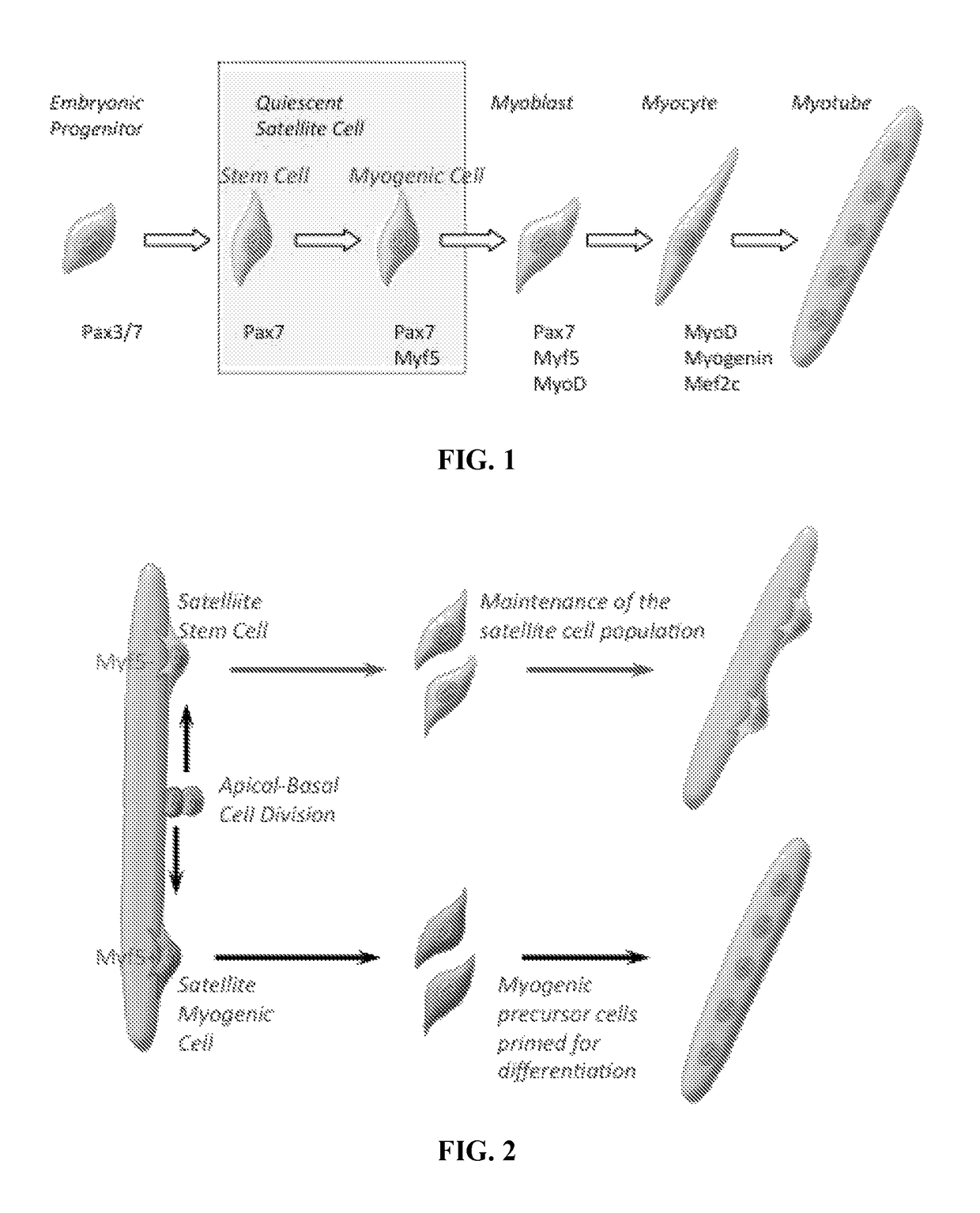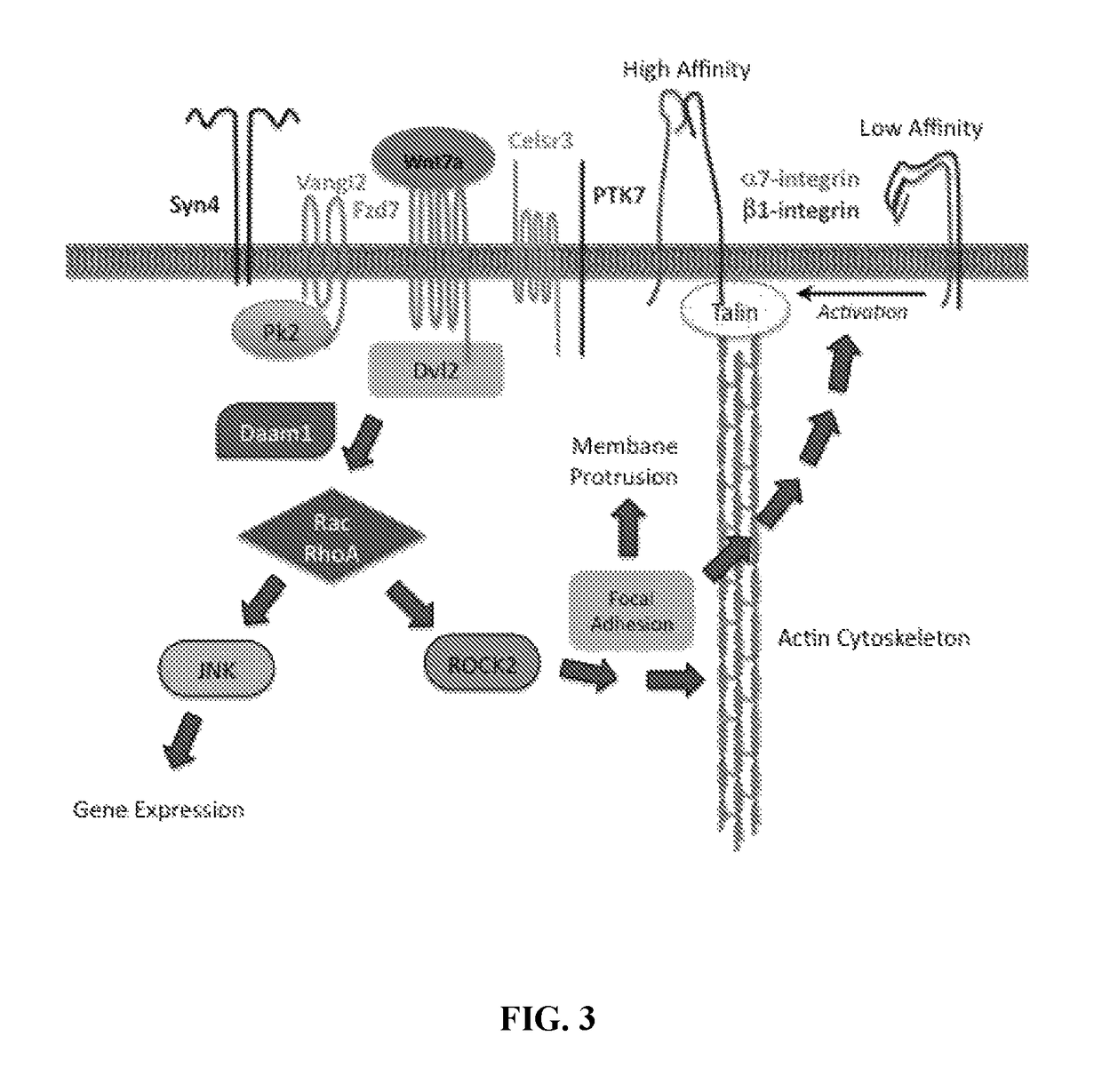Compositions and methods for modulating stem cells and uses thereof
a technology of stem cells and compositions, applied in the field of compositions and methods for modulating stem cells, can solve the problems of long-term corticosteroid use, inability to achieve symmetric stem cell division, and inability to achieve recombinant dna-technology, etc., to achieve the effect of increasing the rate of stem cell division, promoting symmetric stem cell division, and increasing cell survival
- Summary
- Abstract
- Description
- Claims
- Application Information
AI Technical Summary
Benefits of technology
Problems solved by technology
Method used
Image
Examples
example 1
Frizzled7 is Highly Expressed in Quiescent Satellite Stem Cells
[0359]Satellite cells are a heterogeneous population composed of stem cells and committed progenitors. All satellite cells express Pax7 and markers such as CXCR4, however, the present inventors identified a subset of about 10% of Pax7+ cells that have never expressed Myf5 during their developmental history (FIG. 4A). This subset of Pax7+ / Myf5− satellite was identified as a stem cell population within the satellite cell niche (Kuang et al., 2007). Towards performing gene expression analysis of quiescent satellite stem cells, the inventors first developed an improved methodology for satellite cell isolation by fluorescence activated cell sorting (FACS), as described in the Methods section. FACS-purified cells (CD34+, α7-Integrin+, CD31−, CD45−, CD11 b−, Scat) (FIG. 11A), were >95% satellite cells as determined by Pax7 and Syndecan4 expression (FIG. 11B), and exhibited robust growth and differentiation potential in vitro (F...
example 2
Wnt Expression During Muscle Regeneration
[0363]The present inventors hypothesized that Wnt7a was a candidate ligand for Fzd7 receptor. Coexpression of Fzd7 and Wnt7a during embryonic myogenesis had been reported (Cossu and Borello, 1999) and Wnt7a had been implicated as a regulator of embryonic and adult myogenesis (Chen et al., 2005; Polesskaya et al., 2003; Tajbakhsh et al., 1998). Real-Time PCR-Array analysis of freeze-injured TA muscle was employed to document Wnt expression during regenerative myogenesis. Freeze injury of muscle was chosen because of the significantly reduced inflammatory response relative to other methods such as cardiotoxin (CTX) injection. Changes in gene expression were analyzed at 3 days post-injury, during the acute phase of regeneration, where most of the Pax7+ cells are proliferating, and at 6 days post-injury, when satellite cells have returned to a quiescent sub-laminar position (FIG. 5A).
[0364]At 3 days post-injury significant increases (as compared ...
example 3
Symmetry of Satellite Stem Cell Divisions is Regulated by Wnt7a-Frizzled7
[0369]The expression of Fzd7 in quiescent satellite stem cells and the marked upregulation in Wnt7a during muscle regeneration suggested that Wnt7a-Fzd7 signaling is involved in regulating muscle stem cell function. In addition, Wnt7a had no effect on the growth or differentiation of cultured primary myoblasts in vitro (FIG. 16). Therefore, to investigate the role of Wnt7a-Fzd7 signaling in satellite cells, the ability of recombinant Wnt7a to alter the ratio between asymmetric and symmetric cell divisions of satellite stem cells was examinted in vitro. Myofibers were isolated from Myf5-Cre / ROSA26-YFP EDL muscle and cultured under non-adherent conditions. In the culture system, quiescent satellite cells become activated immediately following myofiber isolation. Satellite cells leave their niche, migrate across the basal lamina, and undergo their first cell division in a synchronous fashion. Thus, the outcome of ...
PUM
 Login to View More
Login to View More Abstract
Description
Claims
Application Information
 Login to View More
Login to View More - R&D
- Intellectual Property
- Life Sciences
- Materials
- Tech Scout
- Unparalleled Data Quality
- Higher Quality Content
- 60% Fewer Hallucinations
Browse by: Latest US Patents, China's latest patents, Technical Efficacy Thesaurus, Application Domain, Technology Topic, Popular Technical Reports.
© 2025 PatSnap. All rights reserved.Legal|Privacy policy|Modern Slavery Act Transparency Statement|Sitemap|About US| Contact US: help@patsnap.com



